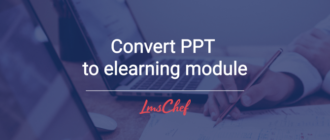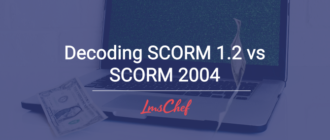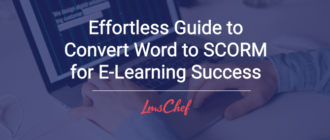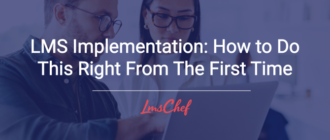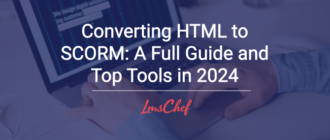As someone who’s spent years helping companies make sense of their LMS decisions, I understand it’s about proving the true value of your investment — to your finance department, your leadership, and even yourself.
But here’s the truth: too often, organizations jump in without fully understanding the hidden expenses or the powerful returns an LMS can generate. And when they’re asked, “How is our LMS investment performing?”, they find themselves at a loss for words, unable to provide clear answers or compelling evidence.
In this guide, I’ll walk you through each step of calculating your LMS ROI, break down every associated cost, pinpoint exactly how your LMS adds value, and show you how to measure performance accurately with clear metrics. Plus, I’ll share proven strategies I’ve gathered over the years to not only measure but also significantly improve your LMS ROI.
Understanding Your LMS Investment: A Cost Breakdown
How do you know how much your LMS costs? Before calculating the LMS ROI, you need to understand the full scope of your investment. Many businesses focus only on the subscription fee or initial setup costs, but the total cost of ownership (TCO) includes several ongoing and sometimes hidden expenses.
Below is a structured breakdown of the key cost factors to consider.
Initial setup and implementation costs
The cost of setting up an LMS varies significantly based on the type of system you choose — whether it’s a cloud-based SaaS LMS, a self-hosted solution, or a custom-built platform:
A cloud-based SaaS LMS typically requires an initial setup fee that ranges from $4,000 to $7,000. Setup costs of a self-hosted LMS can be higher, reaching up to $25,000, due to hosting and IT infrastructure needs.While open-source LMS software itself may be free, development, customization, and implementation can exceed $18,000. Businesses opting for a fully customized LMS can expect costs ranging from $75,000 to over $500,000, compared to $15,000–$100,000 for off-the-shelf solutions.
lms-setup-component-breakdown
| Setup component | What it covers |
| Platform configuration | System setup, branding, and initial customizations |
| Integration support | Connecting the LMS to existing business tools (HR, CRM) |
| Initial training | Training employees, administrators, and instructors |
| Data migration | Transferring existing training materials and user data |
Recurring monthly and annual expenses
After the initial setup, businesses need to account for ongoing costs, which can vary depending on the LMS provider, number of users, and required features.
Small and medium-sized businesses (SMBs) typically spend $2,000 to $10,000 per year on their LMS. Large enterprises may have annual costs of between $50,000 and $200,000.
Most LMS providers charge for more than just software access. Standard ongoing expenses include:
- Software updates and ongoing maintenance
- Technical support and customer service
- Cloud hosting and storage fees
- Security updates and compliance costs
These costs ensure that the LMS remains functional, secure, and aligned with evolving business needs.
Hidden and overlooked LMS costs
Beyond standard fees, several cost factors can impact your total investment, often going unnoticed until they become a financial burden.
| Cost factor | Potential impact |
| User adoption challenges | Poor engagement (because some of the company’s users either don’t want to or are unable to use the LMS) can waste up to 40% of the initial investment. |
| System integration | Poor or missing integration technology costs businesses an average of $500,000 annually. |
| Ongoing maintenance | Regular updates can boost efficiency by up to 30%. |
| Data security risks | 60% of small businesses close within 6 months of a major data breach, according to the National Cybersecurity Alliance. |
To minimize these risks, businesses should carefully evaluate LMS vendor pricing models, ensure smooth user adoption strategies, and assess the total cost of ownership (TCO) instead of just upfront expenses.
Identifying the Benefits of Your LMS
A well-implemented LMS reduces expenses, improves operational efficiency, and enhances employee performance, leading to both direct and indirect financial gains.
Let’s look at two key areas where an LMS drives returns and provides real-world examples to illustrate its impact.
Immediate financial impact
One of the most tangible benefits of an LMS is reducing training-related expenses, including instructor fees, travel expenses, venue costs, and time spent on training (reduced downtime).
| Cost reduction area | Typical savings | Real-world example |
| Training delivery | 25–50% | IMT Matcher reduced training costs by at least 25% by shifting to online training. |
| Travel and venue | 40–60% | IBM cut expenses by nearly 50% using a data-driven LMS approach. |
| Training time | 25–40% | Walmart shortened training duration by 25% during the pandemic. |
Beyond reducing costs, LMS adoption also improves compliance and training effectiveness, ensuring that employees retain knowledge and apply it in their roles.
Long-term impact of LMS adoption
Cost savings are crucial, but an LMS also drives broader operational improvements, enhancing employee performance, productivity, and retention — all of which translate to significant business value.
Many organizations with well-structured LMS programs report:
- 50% higher employee retention rates
- 24% increase in productivity
- 353% return on training investment (That’s $4.53 gained for every $1 spent!)
For instance, Chemonics used an LMS to streamline onboarding, reducing onboarding time by 40% and cutting error rates by 25%, ultimately saving the company over $500,000 over a three-year period.
To quantify your LMS returns, track the right performance indicators across different business areas:
| Metric category | What to measure | Key impact |
| Employee performance | Completion rates, assessment scores | Improved learning outcomes |
| Operational efficiency | Time to competency, task completion | Increased productivity |
| Business impact | Customer feedback, sales figures | Revenue growth |
| Compliance | Audit results, incident rates | Reduced risks |
To fully capitalize on your LMS investment, consider these best practices:
- Create control groups to measure how training affects key performance indicators (KPIs).
- Gather feedback regularly from both learners and supervisors to refine training programs.
- Analyze performance trends before and after LMS implementation.
- Track measurable outcomes, such as increased sales, fewer compliance issues, or reduced employee turnover.
Some studies predict that every time a business replaces a salaried employee, it costs six to nine months of their average salary. This means that even a small improvement in retention rates, driven by better learning and development, can have a significant financial impact on your bottom line.
3 Steps to Evaluate LMS ROI
When you understand how much it costs to adopt an LMS and what benefits it provides your business, it’s time to understand whether the investment paid off. Here’s my proven method.
Step 1. Gather the right data and information
To measure LMS ROI effectively, start by collecting two critical data sets:
- LMS-related costs, including setup, licensing or subscription fees, implementation, training, maintenance, and content development expenses.
- LMS-driven benefits, such as productivity improvements, travel and training cost savings, compliance enhancements, performance gains, and employee retention.
These numbers form the foundation for calculating ROI.
Step 2. Calculate your LMS ROI
Once you have the costs and benefits, use this standard ROI formula:
ROI (%) = [(total benefits – total costs) / total costs] × 100
Let’s look at the example:
| Category | Cost/Benefit ($) |
| Costs | |
| Setup | $15,000 |
| Customization | $30,000 |
| Training | $10,000 |
| Annual subscription | $25,000 |
| Total costs | $80,000 |
| Benefits | |
| Productivity increase | $50,000 |
| Travel savings | $15,000 |
| Compliance improvements | $20,000 |
| Performance gains | $15,000 |
| Total benefits | $100,000 |
So, the ROI is:
ROI = [($100,000 – $80,000) / $80,000] × 100 = 25%
This means your LMS is providing 25% more value than expenditure.
Step 3. Evaluate ROI in the right timeframe
Your ROI percentage provides key insights into your LMS’s performance:
- High (above 20%): your LMS is delivering significant value, and its cost is justified.
- Moderate (5–20%): your LMS is contributing positively, but there’s room for improvement.
- Low (below 5%): your LMS may not be utilized effectively, or costs outweigh the benefits.
For example, Forever Direct achieved a 50% reduction in workplace accidents after implementing the iSpring Learn LMS — proving that safety improvements can boost ROI beyond financial savings.
An important note:
ROI isn’t always immediate, so it’s crucial to evaluate returns over different periods:
- Short-term (3–6 months): focus on cost savings (e.g., reduced travel expenses).
- Mid-term (6–12 months): measure efficiency improvements (e.g., faster onboarding).
- Long-term (1–2 years): assess broader strategic gains, such as revenue growth and employee retention.
According to iSpring’s research results, 40% of organizations spend less than $50,000 on employee training — use this as a point of reference when comparing your LMS investment.
Proven Strategies for Improving ROI Results
I’ve seen organizations excitedly adopt an LMS, only to realize months later that they’re not seeing the returns they expected. Costs pile up, engagement stagnates, and leadership starts questioning whether the system was worth implementing.
The good news is that ROI isn’t static — it’s something you can actively improve. Here are my practical, proven strategies, all based on real-world insights from companies that have mastered their LMS ROI.
Reducing LMS costs
Many companies overpay for their LMS without realizing it. To optimize spending without compromising training quality, first, right-size your licenses. Avoid paying for inactive users by tracking active vs. registered learners and adjusting license tiers accordingly.
Similarly, some LMS providers impose hidden costs for API access, advanced reporting, or storage — costs that can be avoided with thorough contract negotiation and regular vendor reassessment.
Beyond licensing, content development is a major cost driver. Creating courses from scratch requires time, resources, and expertise, but many organizations fail to leverage existing materials. Repurposing existing content (recorded webinars, internal documentation, and instructor-led training sessions) into LMS courses can significantly cut development costs.
Also, don’t neglect AI-powered tools to automate course creation and reduce the workload for course developers. Some organizations also encourage user-generated content, which allows employees to contribute knowledge and best practices at a much lower cost.
Increasing LMS returns
To maximize workforce performance and business impact, an LMS must integrate seamlessly with existing systems rather than function as a standalone tool. Connecting it with HR platforms, performance management tools, and analytics software ensures that training aligns with business objectives and delivers measurable ROI.
AI-driven personalization further enhances returns by adapting learning paths to individual performance, which keeps employees engaged and reduces dropout rates. Predictive analytics can identify at-risk learners early, improving completion rates. Mobile optimization is equally critical — companies that prioritize mobile learning see up to 45% higher retention.
Tracking progress
Too often, organizations assume that once an LMS is in place, the job is done, but real ROI comes from ongoing adjustments based on measurable insights.
As George Koenigsaecker, former President of Danaher’s Tool Group, explains:
“Most managers have a mindset that if you apply a tool once, you’re done… But to get the 400% gain, you have to use it at least 10 different times. You must study the process over and over.”
This principle applies directly to LMS optimization. A sophisticated approach involves tracking a combination of learning, operational, engagement, and financial metrics to gain a clearer picture of LMS impact:
| Metric category | Key indicators | Impact measurement |
| Learning effectiveness | Course completion rates, assessment scores, time to competency | Improved knowledge retention, faster skill acquisition, reduced retraining costs |
| Operational efficiency | Time saved per task, error reduction, automation usage | Increased productivity, lower support ticket volume, reduced training admin workload |
| Employee engagement | Active user rates, session duration, voluntary course enrollments | Greater adoption, stronger learning culture, improved retention rates |
| Financial impact | Cost per learner, revenue per trained employee, training ROI ratio | Direct monetary benefits, improved employee performance, cost savings from reduced employee turnover |
Final Thoughts
When implemented strategically, an LMS can drive measurable improvements in performance, efficiency, and business impact. But the real payoff comes through consistent optimization and informed decision-making.
Now, it’s your move! Take a closer look at your LMS, evaluate its impact, and make the adjustments needed to turn it into a true business asset. Good luck!


